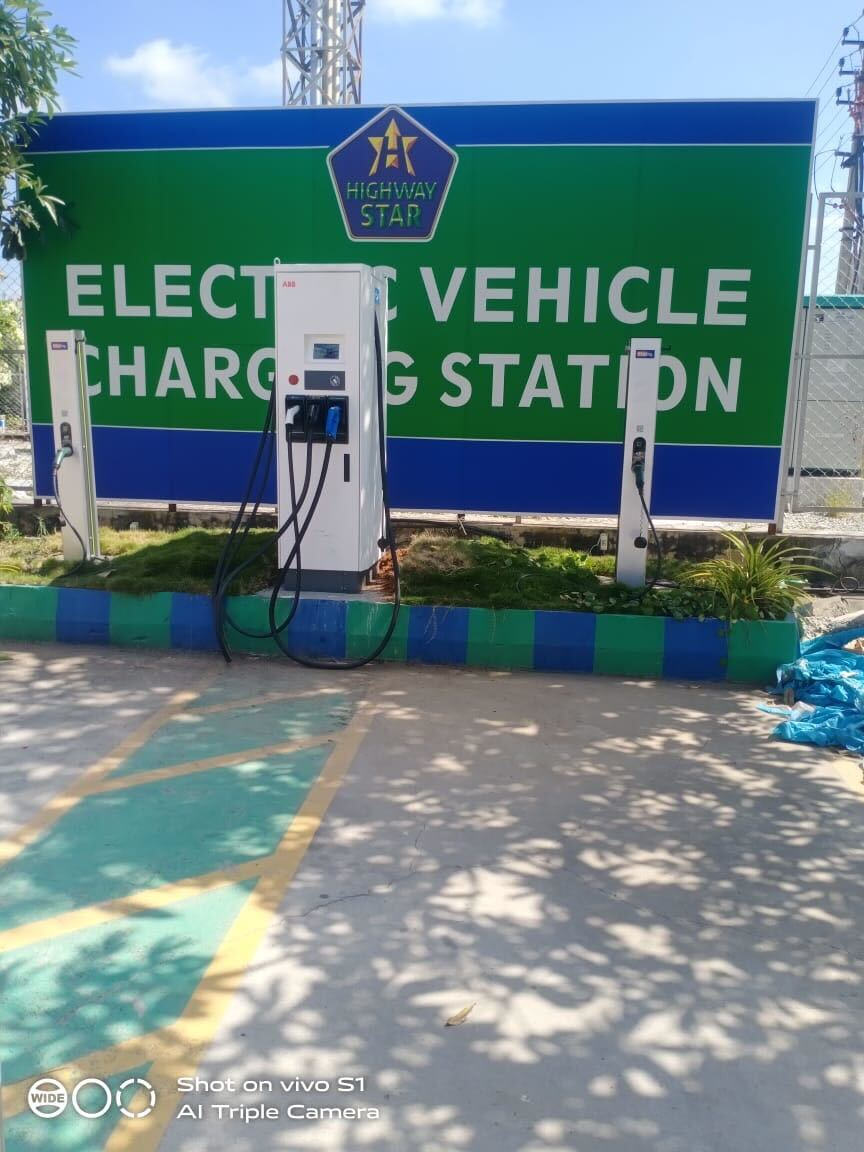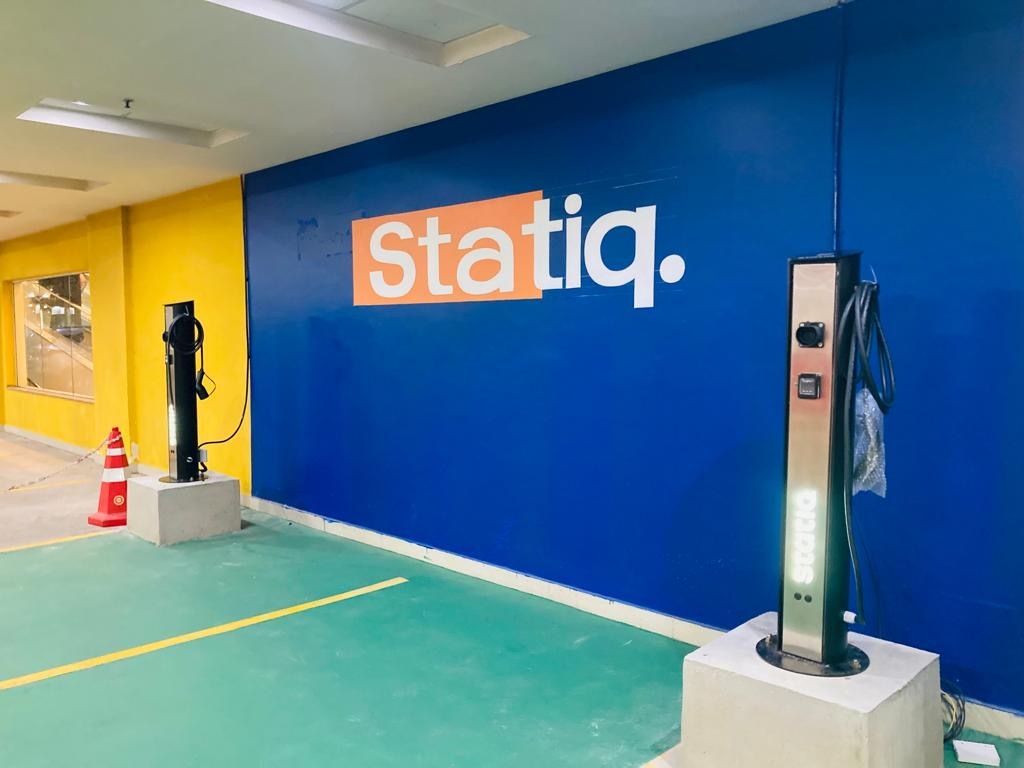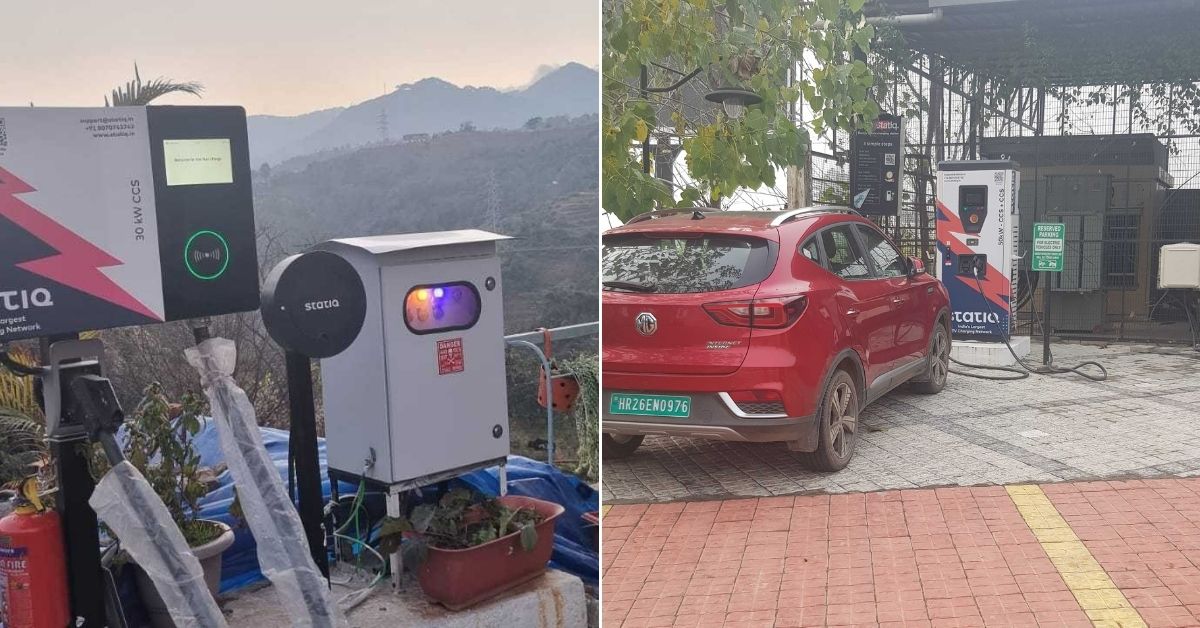With over 600 charging stations spread across more than 40 cities, the Delhi-NCR-based ‘tech-first startup’ Statiq is rising to the challenge of fulfilling the infrastructural needs of India’s growing electric vehicle (EV) market. Building one of India’s smartest EV charging networks with a total operating inventory of 6,400 chargers backed by an app, the startup aims to provide end-to-end service for landowners, EV users and vehicle manufacturers (OEMs).
(Above image of Akshit Bansal and Raghav Arora on the left and a Statiq EV charger on the right)
Founded in 2019 by Akshit Bansal and Raghav Arora, Statiq provides two kinds of charging: slow and fast, and in two formats — pillar (ground-mounted charging point for EVs) and circle (wall-mounted charging point). Their services also extend from two and three to four-wheelers, so that they become the one-stop-charging station for all EVs.
“Our vision is to make sustainable transport possible in India. We have started with building EV charging stations given the issues surrounding the domestic charging infrastructure. We want our EV chargers to be accessible either at your home, office, between the two destinations (intra-city) or inter-city along highways. In addition to accessibility, we want our chargers to be reliable given how many are broken or face other issues like the lack of stable internet connectivity. Another key thing we are bringing with our EV chargers is affordability. These are the three values Statiq is working on,” says Akshit, speaking to The Better India.
Raghav, a data scientist and machine learning expert and Akshit, an electrical engineer by trade, claim that none of the components used in building their EV chargers are imported. On the contrary, most EV chargers in India, they argue, are either imported from European markets or China.
Akshit notes that their commercial EV chargers are 40% cheaper than our competitors in India. “For example, a 60kW DC charger (fast charger) in the Indian market costs about Rs 10-10.5 lakh, whereas our commercial 60kW DC chargers cost around Rs 7.5 lakh because components like controllers are made in-house and materials for it sourced locally,” he claims.
“As a result, the payback period (the amount of time it takes to recover the cost of investment) for our consumers is very less and return on investment is higher compared to conventional chargers. All Statiq EV chargers are connected to an in-house charging station management system giving us and our users information in real-time whether a given charger is available or broken, in use, and issues alarms for other concerns. We are empowered with information that a lot of other charge point operators do not possess,” claims Raghav.

Powered by an App
Underlying their extensive charging network is the Statiq EV charging app. What the app does is aid EV owners in locating the nearest charging stations, booking a slot, allowing payments online, and connecting them with other plug-in EV owners.
“We not only onboard Statiq EV chargers on our app. It’s an aggregated platform where anybody with a property can sign up with us, host their chargers on our platform and we can drive traffic for them. Besides property owners, we also work with various charge point operators who sign up their chargers on our app and we can drive demand for them,” says Akshit.
How can an EV owner use a Statiq EV Charger?
Download the app, log in with your name or phone number and select your vehicle (two or four-wheeler). Based on your selection, you’ll be given a map of all the available and nearest two or four-wheeler compatible chargers. Once you’re equipped with this information, you can visit the charging station and use the app to start charging. It’s a prepaid system, and thus you need to have a certain amount of money in your Statiq wallet. You can stop the charging process through the app itself or it automatically stops if your vehicle is fully charged. Based on the usage of electricity, the money will be auto-deducted from your Statiq e-wallet.
How much will charging at a Statiq station cost a user? It depends on the battery of the vehicle. Statiq charges their consumers on a per kWh basis and not the amount of time spent. They charge two-wheelers at Rs 11 per unit and four-wheelers at Rs 16 per unit of electricity.
“Let’s take the example of the popular Tata Nexon EV, which is the highest-selling Indian electric car today. It has a battery pack of 30kW, i.e. it requires 30 units of electricity to ensure a 0-100% charge. It will cost me Rs 450 to fully charge a Tata Nexon utilising our 60kW Dual-Gun CCS DC Fast Charger. Of course, most of the time EV owners don’t wait for their battery charge to drop to zero before charging. In terms of time spent, however, if you want to charge your EV four-wheeler, it’ll depend on the battery pack,” says Akshit, breaking down the costs.
For a Tata Nexon, which has a maximum intake of 25 units of electricity in an hour, it would approximately take 55 minutes to obtain a 0-80% charge. But for an MG ZS EV, which has a battery pack of 44kW and has a maximum intake of 76 units per hour, it will take up to 35 minutes. This means although the ZS EV has a bigger battery pack it charges faster, he claims.
Their charging stations are located in over 40 cities across India but are predominantly concentrated in Delhi-NCR and the connected regions. They are also present in other metro cities like Mumbai, Pune, Hyderabad and are just starting to build a network in Bengaluru too.

Building a Sustainable Business
Raghav and Akshit began working on Statiq in 2019, but they registered the venture only after developing the prototype of the charger and software. They formally registered the company in January 2020 and began operations too because they already had the product in place.
“We forayed into building EV charging stations because we found that a lot of ventures were already building EVs. But there was a wide gap in the charging infrastructure which affected the adoption of EVs, as per the feedback we received from our market research. Seeing this gap, we wanted to attack this market given mine and Raghav’s expertise in hardware and software.
It’s easy to get into the business of EV charging because any micro-entrepreneur can buy a charger, software operator and start an EV charging business. Having said that, there are many challenges in this market, as you grow bigger,” says Raghav,
Under utilisation of EV chargers is a concern even in the developed world, and the capital expenditure required to build charging stations is very heavy.
“We mitigated this problem by accurately predicting demand based on the extensive data we have collected from OEMs and where chargers will be potentially utilised,” notes Akshit.
For example, Statiq has recently inaugurated a full-stack charging station at Mangalore’s Forum Fiza Mall, where one can charge 2-, 3- and 4-wheelers with ease. The station boasts two charging units, each being a 10.7 kW Type 2 + Smart Plug, Pillar 2.1, which they have manufactured in-house. Statiq selected the Forum Fiza Mall to house this charging station in Mangalore so that people from the city heading to Maravanthe, Chikmagalur or Coorg can make a pit stop for charging their EVs before heading on to their vacations.
Statiq has spent the last year launching as many charging stations as they could in strategic locales to bolster their substantial network. Their charging stations at the Hotel Highway Xpress Delhi Side, Behror, Rajasthan on the NH48; Krishna Hansraj Hotel on Old Hoshiarpur Road, Una and Savoy Greens, Jabli in Himachal Pradesh; Fun and Food Carnival, Khatauli Bypass, Bhainsi, Uttar Pradesh on the NH 58 are all locations that were handpicked because they are located on busy routes and already have extensive footfalls. They have also partnered with companies like NoBrokerHood, WeWork, Airtel, and certain hospitality ventures too.

Of course, the base problem in this space is the high capital expenditure required to build a charging station and not being able to recover this amount.
“Since we build components in-house and source materials locally, we were able to reduce our expenditure resulting in cheaper chargers. We can decrease that payback period (the amount of time it takes to recover the cost of an investment). Another concern is the lack of standardisation in connectors of two-wheelers, although this isn’t a problem with four-wheelers. We don’t just cater to two-wheelers, but all major segments of EVs in India,” says Akshit.
For the time being, they do not set up EV chargers in individual homes, although people can buy them. Statiq will help install them. However, in Delhi-NCR, they have begun installing it for larger residential societies.
“We built an innovative product called AdPod — it’s a charger with advertisement channels. We bear the cost of installing chargers in the society, offer free charging to residents. We generate revenues on the ads that we sell on the AdPod and share that revenue as well. We have just started setting these up,” he says.
Statiq was initially incubated in NASSCOM’s 10000 Start-ups programme. It continued its journey with the prestigious American technology start-up accelerator Y Combinator (YC), in the Summer Cohort of 2020.
Within months of graduating from YC, Statiq managed to close a seed-funding round of $1.8 million in October 2020 towards setting up 100 chargers.
Looking ahead, Statiq wants its app to become a one-stop solution for consumers looking for EV chargers anywhere in the country. In terms of innovation, they want to integrate other renewable energy sources like solar into their charging infrastructure. More importantly, they are also working with OEMs to improve the charging experience for the end consumer.
(Edited by Yoshita Rao)
No comments:
Post a Comment